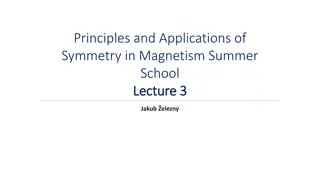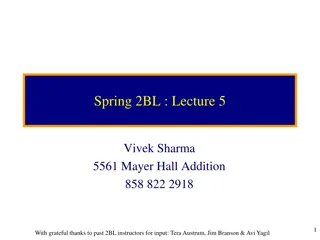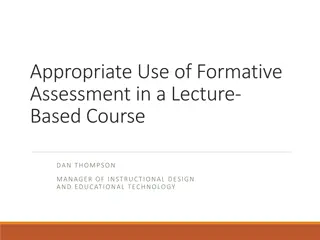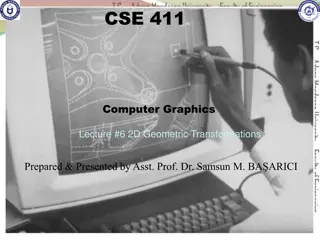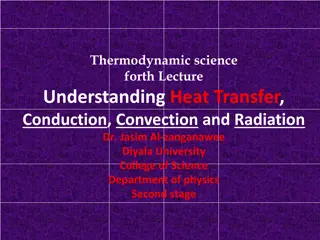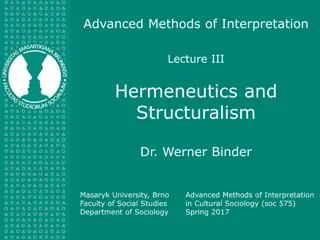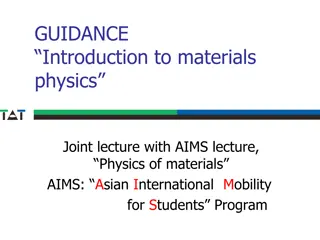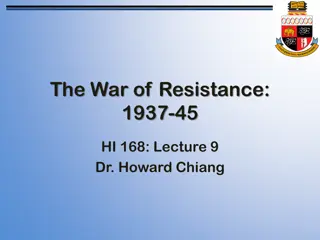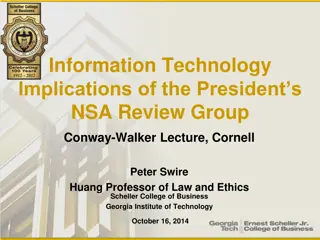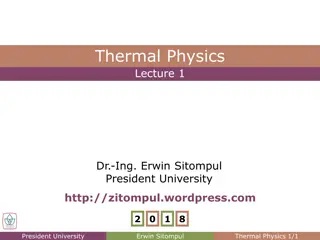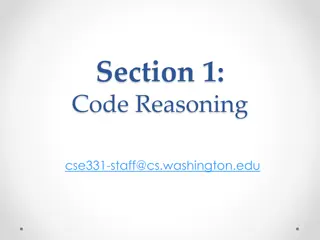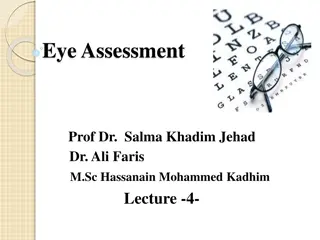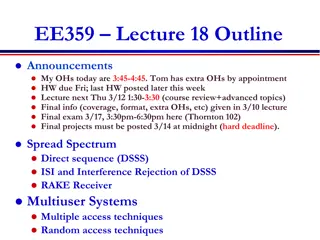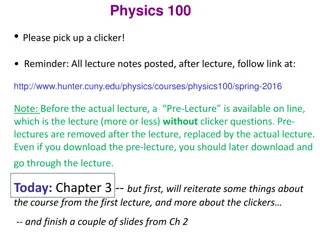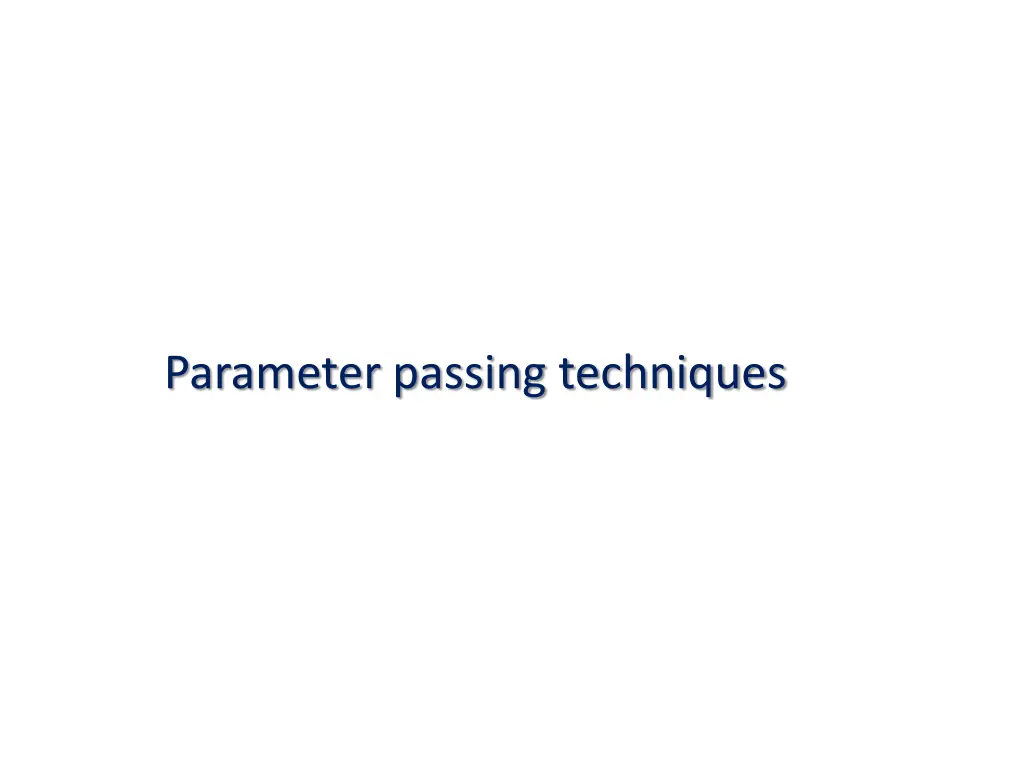
Understanding Parameter Passing Techniques in Functions
Explore the concept of parameter passing techniques in functions, including pass by value and pass by reference methods. Learn how to manipulate values using pointers as function arguments, providing a deeper understanding of how data is exchanged within functions.
Download Presentation

Please find below an Image/Link to download the presentation.
The content on the website is provided AS IS for your information and personal use only. It may not be sold, licensed, or shared on other websites without obtaining consent from the author. If you encounter any issues during the download, it is possible that the publisher has removed the file from their server.
You are allowed to download the files provided on this website for personal or commercial use, subject to the condition that they are used lawfully. All files are the property of their respective owners.
The content on the website is provided AS IS for your information and personal use only. It may not be sold, licensed, or shared on other websites without obtaining consent from the author.
E N D
Presentation Transcript
Functions Functions- -Overview: Overview: Parameters/Arguments Parameters/Arguments Formal parameters Formal parameters void dispNum( int n )// function definition { printf( The entered num=%d , n); } // function definition int main(){ //calling program int no; printf( Enter a number \n ); scanf( %d ,&no); dispNum( no); //Function reference return 0; } Actual parameters Actual parameters 2 CSE 1001 Department of CSE
Functions- Parameter Passing Parameter Passing Pass by value (call by value) Pass by reference (call by reference) 3 CSE 1001 Department of CSE
Pass by value: void swap(int x, int y ) { int t=x; x=y; y=t; printf( In fn: x= %d and y=%d ,x,y); } Output: In fn: x = 7 & y = 5 After swap: a = 5 & b = 7 int main() { int a=5,b=7; swap(a, b); printf( After swap: a= %d and b= %d ,a,b); return 0; } 4 CSE 1001 Department of CSE
Pass by Reference Using Pointers: void swap(int *x, int *y ) { int t=*x; *x=*y; *y=t; } Change Change is is directly using using the the reference reference to directly on on the to the the address address. . the variable variable When When function function is is called address address of of a a address address of of b b called: : x x y y Output Output: : After After swap int main() { int a=5,b=7; swap(&a, &b); printf( After swap: a=%d and b= %d ,a,b); return 0; } swap: : a a = = 7 7 and and b b = = 5 5 5 CSE 1001 Department of CSE
Pointers as functions arguments: When we pass addresses to a function, the parameters receiving the addresses should be pointers. #include <stdio.h> int change (int *p) { int main() *p = *p + 10 ; { return 0; int x = 20; Output : } } change(&x); X after change=30 printf( x after change==%d ,x); return 0; } CSE 1001 Department of CSE 6
Pointers as function arguments When the function change() is called, the address of the variable x, not its value, is passed into the function change(). Inside change(), the variable p is declared as a pointer and therefore p is the address of the variable x. The statement *p=*p +10 adds 10 to the value stored at the address p. Since p represents the address of x, the value of x is changed from 20 to 30. therefore it prints 30. CSE 1001 Department of CSE 7
Function that return multiple values-Using pointers Using pass by reference we can write a function that return multiple values. void fnOpr(int a, int b, int *sum, int *diff) { *sum = a + b; *diff = a -b; } int main() { int x, y, s, d; printf( Enter two numbers: \n ); scanf( %d %d ,&x, &y); fnOpr(x, y, &s, &d); printf( Sum = %d & Diff =%d , s, d); return 0; } Output Output: : Sum Sum = =8 8 & & Diff x= x= 5 5 & & y= y= 3 3 Diff = = 2 2 8 CSE 1001 Department of CSE
Nesting of functions: C language allows nesting of functions by calling one function inside another function. Nesting of function does not mean that we can define an entire function inside another function. The following examples shows both valid and invalid function nesting in C language // Right way of function nesting // Wrong way of function nesting void sleep() { printf( I am having sleep ); } void fun() { printf( I am having Fun . ); void sleep() { printf( I am having sleep ); } } void fun() { printf( I am having Fun . ); sleep(); } 9 CSE 1001 Department of CSE
Nesting of Functions: void First (void){ printf( I am now inside function First\n ); } void Second (void){ printf( I am now inside function Second\n ); First(); printf( Back to Second\n ); } int main (){ printf( I am starting in function main\n ); First (); printf( Back to main function \n ); Second (); printf( Back to main function \n ); return 0; } // FUNCTION DEFINITION // FUNCTION DEFINITION // FUNCTION CALL // FUNCTION CALL // FUNCTION CALL 5/6/2025 CSE 1001 Department of CSE 10
Nesting of Functions: void fnOpr(int a, int b, int *sum, int *diff) { *sum = a + b; if (fnDiff(a,b)) *diff = a -b; else *diff = b - a; } int fnDiff(int p, int q){ if (p>q) return(1); else return (0);} int main() { int x, y, s, d; printf( Enter the values: \n ); scanf( %d %d , &x, &y); fnOpr(x, y, &s, &d); printf( The results are, Sum =%d and Diff = %d , s, d); return 0; } Output Output: : x= x= 3 3 & & y= s s = =8 8 & & d d = = 2 2 y= 5 5 11 CSE 1001 Department of CSE
Passing 1D-Array to Function Rules to pass an array to a function The function must be called by passing only the name of the array. In the function definition, the formal parameter must be an array type; the size of the array does not need to be specified. The function prototype must show that argument is an array. 12 CSE 1001 Department of CSE
Passing 1D-Array to Function: int fnSum( int a[ ], int n) { int sum=0,i; for(i=0;i<n;i++) sum+=a[i]; return (sum); } Output Output: : n= n=5 5 1 1, , 2 2, , 3 3, , 4 4, , 5 5 Sum Sum of of elements elements = = 15 15 int main() { int n, a[20], x, y,i; printf( Enter the limit \n ); scanf( %d ,&n); printf( Enter the values: \n ); for (i=0; i<n; i++) scanf( %d ,&a[i]); printf( The sum of array elements is =%d ,fnSum(a, n));//fn call return 0; } Array name is passed along Array name is passed along with number of elements with number of elements 13 CSE 1001 Department of CSE
Passing 2D-Array to Function: Rules to pass a 2D- array to a function The function must be called by passing only the array name. In the function definition, we must indicate that the array has two-dimensions by including two set of brackets. The size of the second dimension must be specified. The prototype declaration should be similar to function header. 14 CSE 1001 Department of CSE
Passing 2D-Array to Function: int fn2d(int x[ ][10], int m, int n) { int i, j, sum=0; for(i=0; i<m; i++) Output: m=2 n=3 3 4 Sum of elements = 21 1 2 for(j=0; j<n; j++) sum+=x[i][j]; return(sum); 5 6 } int main() { int i, j, a[10][10], m, n; printf("Enter dimentions of matrix"); scanf("%d%d", &m, &n); printf("Enter the elements"); for(i=0;i<m;i++) for(j=0;j<n;j++) scanf("%d",&a[i][j]); printf ("Sum of elements of 2D array is=%d",fn2d(a, m, n)); return 0; } 15 CSE 1001 Department of CSE
Extra problems: Write a c program to add all the even elements of an array using a function Add(). Write a C program to replace all odd numbers of an array with the largest number in the array using a function Replace(). Write a C program to replace all the zeros in the matrix by the trace of the matrix using a function Trace(). Write a C program using pass-by-pointer method to compute the compound interest using a function Compound(). CSE 1001 Department of CSE 16
Write a c program to add all the even elements of an array using a function Add() #include <stdio.h> int Add( int a[ ], int n) { int sum=0,i; for(i=0;i<n;i++) { if((a[i]%2) == 0) sum+=a[i]; } return (sum); } int main() { int n, a[20], x, y,i; printf("Enter the limit \n"); scanf("%d",&n); printf("Enter the values: \n"); for (i=0; i<n; i++) scanf("%d",&a[i]); printf("The sum of even array elements is =%d ",Add(a,n)); Return 0; } CSE 1001 Department of CSE 17
Write a C program to replace all odd numbers of an array with the largest number in the array using a function Replace() #include <stdio.h> void Replace( int arr[ ], int n) { // To find the largest int i, max = arr[0]; for (i = 1; i < n; i++) if (arr[i] > max) max = arr[i]; int main() { int n, a[20], x, y,i; printf("Enter the limit \n"); scanf("%d",&n); printf("Enter the values: \n"); for (i=0; i<n; i++) scanf("%d",&a[i]); Replace(a,n); printf("The array after replacement is\n"); for (i=0; i<n; i++) printf("%d \n",a[i]); // To replace for(i=0;i<n;i++) { if(arr[i]%2 != 0) arr[i]=max; } } return 0; } CSE 1001 Department of CSE 18
Write a C program to replace all the zeros in the matrix by the trace of the matrix using a function Trace() #include <stdio.h> #include <math.h> void Trace(float a[ ][10], int m, int n) { int i, j, norm, sum=0; int main() { int i, j, m, n; float a[10][10]; printf("Enter dimentions of matrix"); scanf("%d %d", &m, &n); printf("Enter the elements"); for(i=0;i<m;i++) for(j=0;j<n;j++) scanf("%f",&a[i][j]); Trace(a, m, n); printf("Matrix after replacement \n"); for(i=0;i<m;i++) { for(j=0;j<n;j++) { printf("%f",a[i][j]); } printf("\n"); } return 0; // Finding Trace for(i=0;i<m;i++) { for(j=0;j<n;j++) sum=sum+a[ i ][ j]*a[ i ][ j ]; } norm=sqrt(sum); //Replacing zeros for(i=0;i<m;i++) for(j=0;j<n;j++) if(a[i][j]==0) a[i][j]=sum; } CSE 1001 Department of CSE } 19
Write a C program using pass-by-pointer method to compute the simple interest and compound interest using a function SI_CI() #include <stdio.h> #include <math.h> int main() { float p,q,r,SI,CI; int n; printf("Enter the value of Principal p = "); scanf("%f",&p); printf("Enter the value of Rate r = "); scanf("%f",&r); printf("Enter the value of Period in year n = "); scanf("%d",&n); SI_CI(&p,&r,&n,&SI,&CI); printf("Simple Interest SI=%f \n",SI); printf("Compound Interest CI=%f \n",CI); return 0; } CSE 1001 Department of CSE 20
Write a C program using pass-by-pointer method to compute the simple interest and compound interest using a function SI_CI() void SI_CI(float *pr, float *ra, int *yr, float *smp, float *cmp) { int amount; // Simple interest *smp = ((*pr)*(*ra)*(*yr)/100); // Compound interest amount= (*pr)*pow((1 +(*ra)/100),(*yr)); *cmp= amount-(*pr); } CSE 1001 Department of CSE 21


